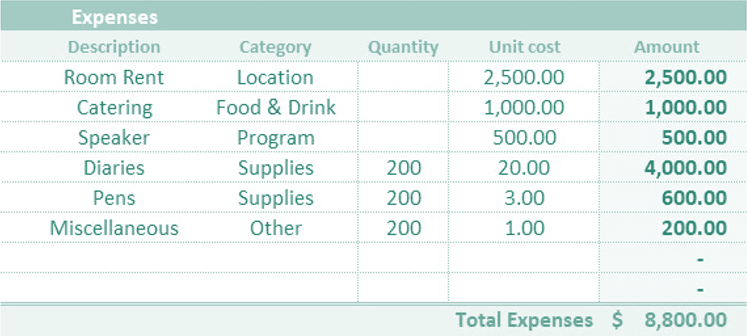Table of Contents
Free Event Budget Template
One may use an event budget template to plan the finances related to event management, which includes the income obtained, which may be in the form of sponsorships or registration/ticket charges, and the expenses, which might be food, accommodation, sound, gifts, etc. The difference obtained is the profit or loss made from organizing the event. If the balance amount is positive, the event has made some money. On the other hand, the event organizer had to spend from their pocket if the balance amount was negative.
Please refer to the Excel file for the template. The template is for a typical event like an office seminar where different expenses and incomes related to organizing such an event are captured. The expense and income have shown in two separate sections.
About the Event Budget Template
- The event budget template captures all the sources of income one has for organizing the event and also the spending. It sets up an initial budget balance and gives an end balance projection, which is expected to be there after deductions of all the income expenses. Here, we have specifically taken an example of organizing an event for a seminar.
- The seminar can be an office seminar where we have some 200 attendees estimated to attend, and the organizer has to bear their food and give them custom-made goodies. The goodies are used as a company’s promotional source, and a third-party vendor usually provides it.
Part #1

- Here, we capture the overall expense and income made for organizing the event, which we have taken as an example of a seminar. The seminar is organized for an office delegation with an estimated attendance of 200, but we had around 150 attendants.
- Further, the expenses are divided into location, program, food and drinks, and supplies. The balance here shows if one spent more money than the budget or if we had some income after organizing the event. Finally, one showed the graph to give a pictorial view of the expenses and actual income with the estimated income.
Part #2

- This section shows a breakdown of the expenses to organize the event. In our case, we are taking the example of an office seminar. For organizing such an event, a couple of fields need to make the expenses. The most significant amount for organizing the event is towards the location or the event hall. Depending on the location of the event, the rates of organizing the event vary.
- The second-highest cost of organizing the event is catering or food. Again, it varies according to the number of attendants. Generally, it is estimated as more than the number who attend the event. Primarily, one makes it to keep a buffer on the number of attendees to an event so that they don’t fall short of food plates.
- Then, the cost is related to speakers or the electronic instruments used in the event. These are some mandatory costs needed for organizing any event. For every event, a gift or custom-made goodies are given to the attendees based on the event’s headcount.
- Generally, these are tied with third-party vendors who supply the goodies based on the headcount. These are considered more promotional items the company uses to promote its name. Also, these act as a feel-good factor for the attendants of an event.
- The last and final cost for organizing a seminar is the miscellaneous costs like petty expenses. Still, these should also be accounted for in the overall expense to get a final picture of the cost of organizing the event.
Part #3

- The final part here is the income or funding part of the event. Any event is not possible if there is no funding or income generated. No business will organize an event if there is no funding or profit earned from it.
- The prime source of income or funding in any event, is the registration price or the tickets sold for the event. Here, the income is generated on a per-head basis.
- The attendees attending the event have to pay upfront for the registration or the ticket to the event, and in this way, the organizer makes money to cover up the event. The sponsorship fees are the second source of income for any event, which comes in handy in arranging the event.
- Sponsors, in a way, get a promotion too in such places where people in significant numbers come and attend the event. So it becomes a win-win situation for both the organizer and the sponsor, and through sponsorship fees, the organizer gets a second source of income. In addition, the sponsor receives a form of promotion among many crowds under a single roof.
- Thus, this section shows the overall income generated for arranging an event. It now depends on the event’s size and the target income or money the organizer plans to raise to cover the expense.
How to Use This Template?
The template is handy, managing every organizer’s event-related expenses and income. The template’s primary aim is to capture the entire income source and match it with all the expenses an organizer has to bear for every event. It includes both recurring and non-recurring. The result or the difference obtained compared with a budget amount set at the start of the month, and finally, we arrive at a net. The template is very useful when one needs to know the cash inflow and outflow for organizing an event.


